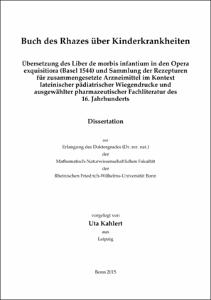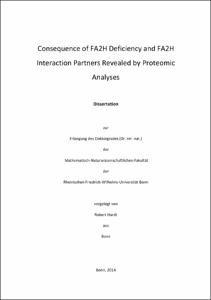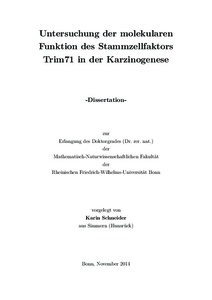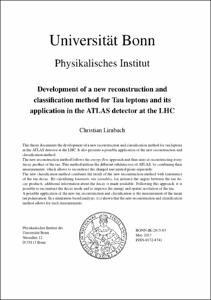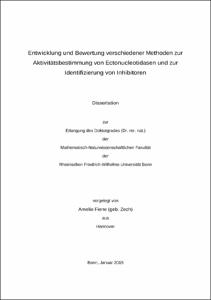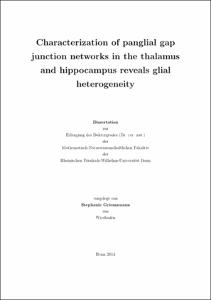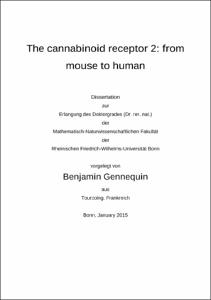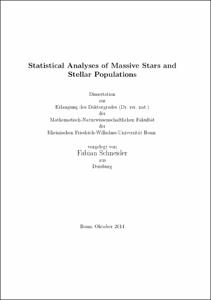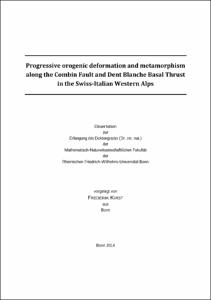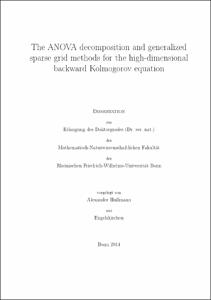E-Dissertationen: Search
Now showing items 1-10 of 215
Buch des Rhazes über Kinderkrankheiten: Übersetzung des Liber de morbis infantium in den Opera exquisitiora (Basel 1544) und Sammlung der Rezepturen für zusammengesetzte Arzneimittel im Kontext lateinischer pädiatrischer Wiegendrucke und ausgewählter pharmazeutischer Fachliteratur des 16. Jahrhunderts
(2015-06-11)
Von dem berühmten persischen Arzt und Philosophen Rhazes (865-925) ist in lateinischer Sprache ein Traktat über Kinderkrankheiten überliefert. Der Text des Liber de morbis infantium mit 24 Kapiteln, entnommen aus dem ......
A tractate about children's diseases by the famous Persian physician and philosopher Rhazes (865‑925) was historically handed down in a Latin version. The Liber de morbis infantium with 24 chapters, having its origin in ......
A tractate about children's diseases by the famous Persian physician and philosopher Rhazes (865‑925) was historically handed down in a Latin version. The Liber de morbis infantium with 24 chapters, having its origin in ......
Consequence of FA2H Deficiency and FA2H Interaction Partners Revealed by Proteomic Analyses
(2015-03-10)
Fatty acid-2 hydroxylase (FA2H) is a 43 kDa transmembrane protein residing in the endoplasmic reticulum. As a monooxygenase it is responsible for the alpha–hydroxylation of fatty acids, which are later incorporated into ...
Untersuchung der molekularen Funktion des Stammzellfaktors Trim71 in der Karzinogenese
(2015-07-28)
Trim71 ist ein hoch konserviertes Gen, das in Vertebraten und Invertebraten als Regulator der Embryonalentwicklung entdeckt wurde. Außerdem konnten neuere Studien zeigen, dass Trim71 eine wichtige Rolle in der Kontrolle ...
Development of a new reconstruction and classification method for Tau leptons and its application in the ATLAS detector at the LHC
(2015-05-13)
This thesis presents a new method for the reconstruction and classification of hadronically decaying tau leptons in the ATLAS detecor at the LHC. It also presents a possible application of the new methods.
The new ......
The new ......
Entwicklung und Bewertung verschiedener Methoden zur Aktivitätsbestimmung von Ectonucleotidasen und zur Identifizierung von Inhibitoren
(2015-05-27)
Ectonucleotidasen werden ubiquitär im Körper exprimiert und sind an vielen (patho)physiologischen Prozessen beteiligt. Sie sind daher als potentielle Arzneistofftargets von großem Interesse (z. B. in der ...
Characterization of panglial gap junction networks in the thalamus and hippocampus reveals glial heterogeneity
(2015-05-27)
Increasing evidence over the past decades revealed the importance of glia in the brain. In this study, astrocytes in the ventrobasal thalamus were characterized in detail for the first time. Glial heterogeneity was ...
The cannabinoid receptor 2: from mouse to human
(2015-05-13)
The endocannabinoid system (ECS) regulates numerous cellular and physiological processes. Nowadays, the system comprises two G protein-coupled receptors named CB1 and CB2 receptor, and the endogenous ligands anandamide ......
Statistical Analyses of Massive Stars and Stellar Populations
(2015-03-04)
Massive stars, i.e. stars more massive than about ten times that of the Sun, are key agents in the Universe. They synthesise many of the chemical elements that are so important for life on Earth, helped reionising the early ...
Progressive orogenic deformation and metamorphism along the Combin Fault and Dent Blanche Basal Thrust in the Swiss-Italian Western Alps
(2015-03-24)
In the Western Alps of Switzerland and Italy, a stack of oceanic and continental units assembled during Late Cretaceous – Paleogene Alpine subduction, exhumation, and accretion. In the study area in the southern Valais and ...
The ANOVA decomposition and generalized sparse grid methods for the high-dimensional backward Kolmogorov equation
(2015-03-12)
In this thesis, we discuss numerical methods for the solution of the high-dimensional backward Kolmogorov equation, which arises in the pricing of options on multi-dimensional jump-diffusion processes.
First, we apply ...
First, we apply ...


